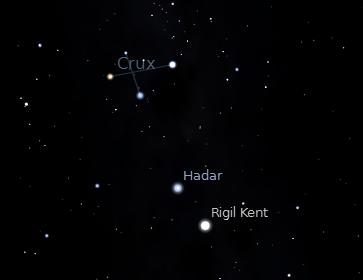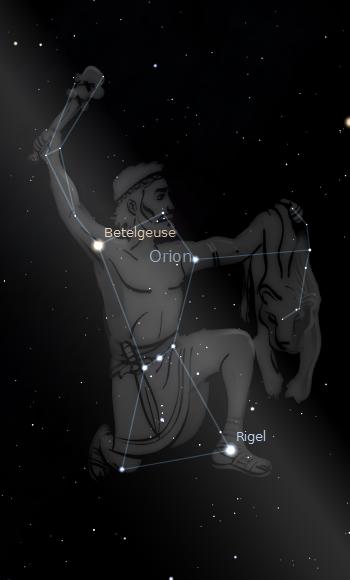Constellations
Contents
What are Constellations?
Constellations are a group of stars in space that create shapes when linked together with invisible lines. These stars can be viewed from earth in the night sky. The most famous constellation in the southern hemisphere is the Southern Cross, which is also known as the 'Crux'. It can be found using the two pointers - 'Hadar' and 'Rigil Kent'.
Another well known constellation is the Orion. The Orion is a constellation that is shaped as a person known as 'The Hunter'. However, most people only know about Orion's belt which is the actual belt that Orion (The Hunter) is wearing. It is also seen as the base of 'the pot' in the night sky.
In the northern hemisphere, a famous constellation is the Ursa Major, also known as 'The Great Bear'.
Many constellations in the northern hemisphere appear upside down when viewed from the southern hemiphere. The 'pot' image is an example of how we see some contellations from here in New Zealand.
How many constellations are there and what are they called?
There are 88 constellations in total:
Andromeda (The Princess)
Antlia (The Air Pump)
Apus (The Bird of Paradise)
Aquarius (The Water Bearer)
Aquila (The Eagle)
Ara (The Altar)
Aries (The Ram)
Auriga (The Charioteer)
Bootes (The Herdsman)
Caelum (The Sculptor's Chisel)
Camelopardalis (The Giraffe)
Cancer (The Crab)
Canes Venatici (The Hunting Dogs)
Canis Major (The Great Dog)
Canis Minor (The Lesser Dog)
Capricornus (The Sea Goat)
Carina (The Keel of the Ship Argo)
Cassiopeia (The Queen and Wife of Cepheus)
Centaurus (The Centaur)
Cepheus (The King of Ethiopia)
Cetus (The Sea Monster)
Chamaeleon (The Chameleon)
Circinus (The Compasses)
Columba (The Dove)
Coma Berenices (The Hair or Bernice)
Corona Australis (The Southern Crown)
Corona Borealis (The Northern Crown)
Corvus (The Crow)
Crater (The Cup)
Crux (The Southern Cross)
Cygnus (The Swan)
Delphinus (The Dolphin)
Dorado (The Goldfish)
Draco (The Dragon)
Equuleus (The Little Horse)
Eridanus (The River)
Fornax (The Furnace)
Gemini (The Twins)
Grus (The Crane)
Hercules (Hercules the Warrior)
Horologium (The Clock)
Hydra (The Water Serpent)
Hydrus (The Water Snake)
Indus (The American Indian)
Lacerta (The Lizard)
Leo (The Lion)
Leo Minor (The Lion Cub)
Lepus (The Hare)
Libra (The Scales)
Lupus (The Wolf)
Lynx (The Lynx)
Lyra (The Lyre)
Mensa (The Table Mountain)
Microscopium (The Microscope)
Monoceros (The Unicorn)
Musca (The Fly)
Norma (The Carpenter's Square)
Octans (The Octant)
Ophiuchus (The Serpent Bearer)
Orion (The Hunter)
Pavo (The Peacock)
Pegasus (The Winged Horse)
Perseus (The Hero, rescuer of Andromeda)
Phoenix (The Pheonix)
Pictor (The Painter's Easel)
Pisces (The Fishes)
Piscis Austrinus (The Southern Fish)
Puppis (The Stern of the ship Argo)
Pyxis (The Compass Box)
Reticulum (The Net)
Sagitta (The Arrow)
Sagittarius (The Archer)
Scorpius (The Scorpion)
Sculptor (The Sculptor)
Scutum (The Shield)
Serpens (The Serpent)
Sextans (The Sextant)
Taurus (The Bull)
Telescopium (The Telescope)
Triangulum (The Triangle)
Triangulum Australe (The Southern Triangle)
Tucana (The Toucan)
Ursa Major (The Great Bear)
Ursa Minor (The Little Bear)
Vela (The Sail of the ship Argo)
Virgo (The Virgin)
Volans (The Flying Fish)
Vulpecula (The Fox)
The constellations that can be seen from New Zealand (southern hemisphere):
Antlia (The Air Pump)
Apus (The Bird of Paradise)
Aquarius (The Water Bearer)
Aquila (The Eagle)
Ara (The Altar)
Aries (The Ram)
Caelum (The Sculptor's Chisel)
Cancer (The Crab)
Canis Major (The Great Dog)
Canis Minor (The Lesser Dog)
Capricornus (The Sea Goat)
Carina (The Keel of the Ship Argo)
Centaurus (The Centaur)
Cetus (The Sea Monster)
Chamaeleon (The Chameleon)
Circinus (The Compasses)
Columba (The Dove)
Coma Berenices (The Hair or Bernice)
Corona Australis (The Southern Crown)
Corona Borealis (The Northern Crown)
Corvus (The Crow)
Crater (The Cup)
Crux (The Southern Cross)
Delphinus (The Dolphin)
Dorado (The Goldfish)
Equuleus (The Little Horse)
Eridanus (The River)
Fornax (The Furnace)
Gemini (The Twins)
Grus (The Crane)
Horologium (The Clock)
Hydra (The Water Serpent)
Hydrus (The Water Snake)
Indus (The American Indian)
Leo (The Lion)
Leo Minor (The Lion Cub)
Lepus (The Hare)
Libra (The Scales)
Lupus (The Wolf)
Mensa (The Table Mountain)
Microscopium (The Microscope)
Monoceros (The Unicorn)
Musca (The Fly)
Norma (The Carpenter's Square)
Octans (The Octant)
Ophiuchus (The Serpent Bearer)
Orion (The Hunter)
Pavo (The Peacock)
Pegasus (The Winged Horse)
Phoenix (The Pheonix)
Pictor (The Painter's Easel)
Pisces (The Fishes)
Piscis Austrinus (The Southern Fish)
Puppis (The Stern of the ship Argo)
Pyxis (The Compass Box)
Reticulum (The Net)
Sagitta (The Arrow)
Sagittarius (The Archer)
Scorpius (The Scorpion)
Sculptor (The Sculptor)
Scutum (The Shield)
Serpens (The Serpent)
Sextans (The Sextant)
Taurus (The Bull)
Telescopium (The Telescope)
Triangulum (The Triangle)
Triangulum Australe (The Southern Triangle)
Tucana (The Toucan)
Vela (The Sail of the ship Argo)
Virgo (The Virgin)
Volans (The Flying Fish)
Vulpecula (The Fox)
Who invented them and how are the constellations named?
The northern constellations got their names throught the ancient Minoans which were passed on to the greeks to get to us. The southern constellations were not known until the europeans started exploring down there in the 1500's - 1700's. Although the polynesians probably had their own set of constellations, they are not the ones we see here today. The constellations are named by their brightness and the letters of the Greek alphabet.
However, these are constellation names that we use in western civilization today. Africans, Polynesians, Asians and Indians may have had other names for them. We will most probably keep the same names for the constellations, even if the stars change their positions. Constellations are, after all, products of human imagination, not nature.
Are constellations permanent or do they change?
Ancient astronomers always said that the stars in the sky were "fixed stars," which stayed in permanent positions in the sky. Although, the stars do seem almost fixed in place and the patterns they form look exactly the same today as they did when the constellations were first named nearly 3000 years ago. The stars are actually all moving relatively to the Sun, most with speeds of many kilometers per second. Because they are so very far away, it will take thousands of lifetimes to see significant changes in the star patterns. However, over millions of years, the motions of the earth and distant stars will change some of their shapes. For example, the tail of the Urse Major (in about 50,000 years) will appear significantly more bent than it is today.
Even though stars in a constellation appear to be grouped together, they may be many light years distant from each other. They seem to be in groups because they lie in the same direction when viewed from Earth. If we pick a constellation that we can see from Earth, then stand anywhere else in our galaxy and look back at that same constellation, It would appear as a diferent shape.
Why can we still see the same 88 constellations from Earth as we orbit the Sun?
No matter what place we are in in the orbit around the Sun, the constellations are many light years away so even if the Earth moves around the sun it is considered a small movement that cannot be noticed far away. The view of the stars will always be there.
Did you know...
- Modern scientists have discovered that the human body is set to withstand the Earth's gravity. The greater the planet is, the greater the gravitational pull, so if we were to migrate to a larger planet about twice the size of Earth, the gravity will be too strong and it would kill us.
- The star, Betelgeuse, from the constellation Orion is a White Dwarf. It is known to explode to become a Supernova very soon. Although, it could happen tommorrow or in a million years from now. When it explodes, it will be bright enough that we will be able to see it in the daytime.



